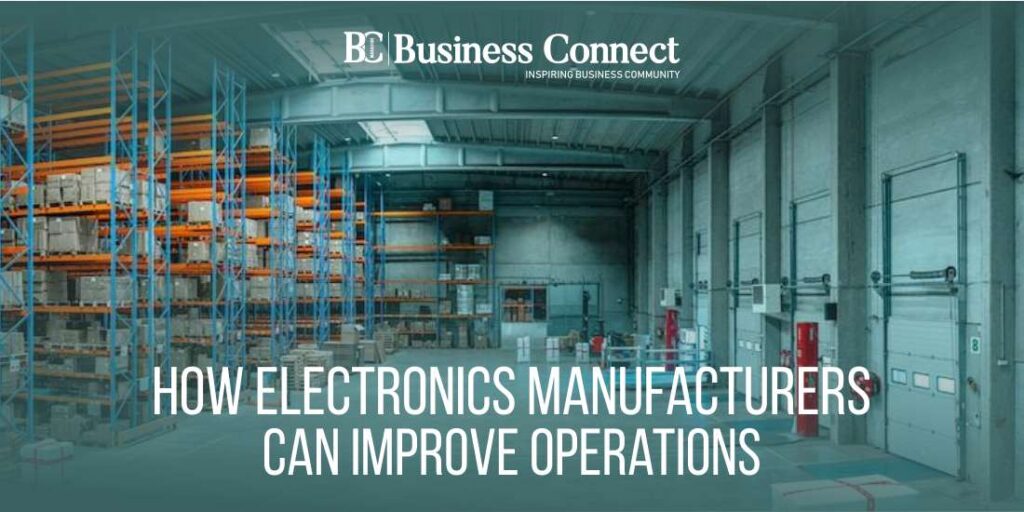How Electronics Manufacturers Can Improve Operations
In this dynamic world, electronics manufacturers face a multitude of challenges in managing their operations effectively, ranging from high production costs, quality control issues, and supply chain complexities to evolving customer expectations and regulatory constraints.
Better operational strategies can lead to improved efficiency, reduced waste, lower costs, better product quality, and ultimately, higher customer satisfaction. There are several tried and true strategies that can help electronics producers improve their operations. In this article, we will explore four key areas where these improvements can be made.
Enhancing Supply Chain Management
Effective supply chain management is of paramount importance for electronics manufacturers. It is a complex process that includes sourcing raw materials, managing suppliers, controlling inventory, and coordinating with logistics providers.
By optimizing their supply chain tasks, manufacturers can minimize costs, improve efficiency, and alleviate the risks of supply chain disruption. Key strategies include establishing strong relationships with reliable suppliers, implementing advanced forecasting techniques to reduce inventory buffers, and employing logistics solutions to ensure prompt delivery.
At the foundational level, the use of high-quality, reliable materials and components is also critical. This includes using quality plastic caps and plugs in electronic devices to protect them from dust, vibration, and electric shock. By focusing on every little detail, electronics manufacturers can enhance their supply chain performance and thereby, their overall operational effectiveness.
Implementing Efficient Equipment Management Practices
Equipment management is the backbone of any manufacturing operation. Keeping a tab on the wear and tear of machinery, scheduling repairs, and replacing outdated equipment is critical to ensure smooth operations. However, managing thousands of pieces of equipment without a streamlined process can lead to confusion, missed maintenance tasks, and eventually, machine breakdowns and production delays.
Here’s where advanced equipment checkout software from Cheqroom can make a difference. The software not only automates equipment tracking but also facilitates easy scheduling of routine maintenance and effective management of equipment lifecycle. This technology allows for efficient scheduling of tasks, real-time tracking of equipment status, and instant alerts for critical issues, ensuring that all equipment is running at its optimal efficiency.
Leveraging Advanced Manufacturing Technologies
Advanced manufacturing technologies such as robotics, automation, and 3D printing are transforming the way electronic products are made. Robotics and automation can help manufacturers increase production speed, improve accuracy, and reduce labor costs. 3D printing, on the other hand, can be used to create complex components that would be difficult or expensive to produce using traditional manufacturing methods.
Furthermore, manufacturers can tap into the power of the Internet of Things (IoT) to gain real-time insights into their production processes. Smart sensors installed in manufacturing equipment can collect and analyze data, enabling manufacturers to predict and prevent machine failures, optimize energy usage, and improve overall process efficiency. With the connected factory, manufacturers can achieve a high degree of automation and intelligence in their operations, promoting quick decision-making, speeding up production, and reducing costs.
Strengthening Quality Control Mechanisms
Quality control is a critical element in every manufacturing operation, and the electronics industry is no exception. Producing high-quality products consistently is crucial to retain customer trust and stay competitive. Given the high complexity and small size of many electronic components, rigorous testing and inspection procedures are key to detect defects early and prevent faulty products from reaching the market.
Developing robust quality control systems requires a combination of state-of-the-art inspection equipment, skilled personnel, and effective processes. Automated inspection technologies can help detect defects quickly and accurately, reducing reliance on manual inspections. Augmented reality (AR) and machine learning can further enhance inspection accuracy by enabling precise identification of defects and predicting failure patterns.
Altogether, a successful operations improvement strategy for electronics manufacturers involves optimal supply chain management, leverage of advanced manufacturing technologies, robust quality control mechanisms, and efficient equipment management practices. By focusing on these areas, manufacturers can ensure high-quality output, efficiency, cost savings, and enhanced competitiveness in the dynamic electronics manufacturing sector.
Must Read:-
- Stock Market Update
- Top 10 shoe brands in India for men & women 2023
- Top 10 Adorable Gifts for Your Special One
- Top 10 Countries with Maximum Indian Population as Citizens
- Top 10 Small Business Statistics You Need to Know For 2023
- Top 10 highest-paid CEO in the World
- Top 10 richest person of India
- Top 10 Highest-Paid CEOs of India
- Top 10 Most Selling Bikes and Scooters of 2022 in India
- The Success Story of Jeff Bezos
- Success Story Of Elon Musk
- Top 10 Business Newspaper In India



